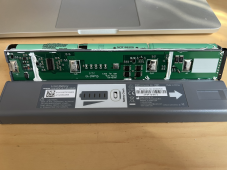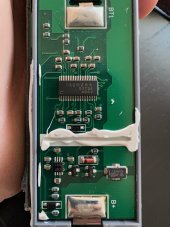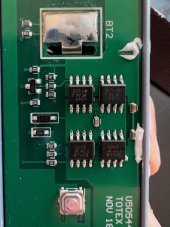Greetings,
I am new to the community. I came to know about the forum through Will’s YouTube channel.
I have been wanting to build a LiFePO4 battery pack for some time now but even more so now that I have found some reputable US-based suppliers.
I recently purchased (117) Panasonic NCR18650A 2.9Ah cells for $143 after shipping. They are sourced from new stock Vyaire Li-Ion battery packs used for ventilators which are rated as 10.8 VDC 8.7 Ah 94 Wh. I originally paid around $32 for a single battery pack on eBay as I was planning to repurpose the cells for several electronics. However, when I saw this recent deal pop up I couldn't help myself as I was able to convince myself.
https://batteryhookup.com/products/new-case-of-108-panasonic-ncr18650a-2900mah-cells
I would ideally like to maintain the packs without fully disassembling them but not immediately sure how I would wire up 13 of these packs. It would be nice to know what the existing pins/positions on the factory power connector are used for. If anyone can help identify this information I would greatly appreciate it.
I couldn't find any other forums/threads of people repurposing these particular packs. If anyone is aware of any resources or documentation I would add me in my understanding and project I would appreciate it.
If I did fully disassemble I was thinking to do a 13s9p configuration for a 48V pack. However, I am still obviously undecided and open to suggestions/recommendations. A 12V pack seems the most practical but like the idea of having the option to use with an electric bike or similar. As I already own this inverter I was leaning towards a 12V configuration. https://www.amazon.com/gp/product/B07J4ZXVTS/ref=ppx_yo_dt_b_search_asin_title?ie=UTF8&psc=1
I previously disassemble the first pack I got from eBay several weeks ago so knew what I was getting into before placing the larger order. As I am not an electrical engineer I do not know much about the components on the circuit board.
Panasonic NCR18650A specs:
Please let me know if there is a more appropriate forum where I should be posting this topic.
Does anyone else have experience with these particular battery packs and/or cells?
Does anyone have build recommendations and/or suggestions? 12V vs 24V vs 48V etc.
Thanks for stopping by and viewing/sharing!
I am new to the community. I came to know about the forum through Will’s YouTube channel.
I have been wanting to build a LiFePO4 battery pack for some time now but even more so now that I have found some reputable US-based suppliers.
I recently purchased (117) Panasonic NCR18650A 2.9Ah cells for $143 after shipping. They are sourced from new stock Vyaire Li-Ion battery packs used for ventilators which are rated as 10.8 VDC 8.7 Ah 94 Wh. I originally paid around $32 for a single battery pack on eBay as I was planning to repurpose the cells for several electronics. However, when I saw this recent deal pop up I couldn't help myself as I was able to convince myself.
https://batteryhookup.com/products/new-case-of-108-panasonic-ncr18650a-2900mah-cells
I would ideally like to maintain the packs without fully disassembling them but not immediately sure how I would wire up 13 of these packs. It would be nice to know what the existing pins/positions on the factory power connector are used for. If anyone can help identify this information I would greatly appreciate it.
I couldn't find any other forums/threads of people repurposing these particular packs. If anyone is aware of any resources or documentation I would add me in my understanding and project I would appreciate it.
If I did fully disassemble I was thinking to do a 13s9p configuration for a 48V pack. However, I am still obviously undecided and open to suggestions/recommendations. A 12V pack seems the most practical but like the idea of having the option to use with an electric bike or similar. As I already own this inverter I was leaning towards a 12V configuration. https://www.amazon.com/gp/product/B07J4ZXVTS/ref=ppx_yo_dt_b_search_asin_title?ie=UTF8&psc=1
I previously disassemble the first pack I got from eBay several weeks ago so knew what I was getting into before placing the larger order. As I am not an electrical engineer I do not know much about the components on the circuit board.
Panasonic NCR18650A specs:
- 2.9 Ah per cell
- 3.6V nominal
- Standard charging: 4.2V, 590mA, 60mA end
- Quick charging: 4.2V, 1475mA, 60mA end
- Standard discharging: 580mA (Constant current, 2.5V end)
- Continuous allowable discharging current: 3540mA (45°C or under)
- Maximum discharge current: 5800mA
- 12v
- 4s29p (116) cells = 1211.04Wh
- Standard charging: 16.8V, 17.11A
- Quick charging: 16.8V, 42.77A
- Standard discharging current: 16.82A * 12V = 201.84W
- Continuous allowable discharging: 102.66A * 12V = 1231.92W
- Maximum discharge current: 168.2A * 12V = 2018.4W
- 4s29p (116) cells = 1211.04Wh
- 24V
- 7s16p (112 cells) = 1169.28Wh
- Standard charging: 29.4V, 9.44A
- Quick charging: 29.4V, 23.6A
- Standard discharging current: 9.28A * 24V = 222.72W
- Continuous allowable discharging: 56.64A * 24V = 1359.36W
- Maximum discharge current: 92.8A * 24V = 2227.2W
- 7s16p (112 cells) = 1169.28Wh
- 48v
- 13s9p (117 cells) = 1255.41Wh
- Standard charging: 54.6V, 5.31A
- Quick charging: 54.6V, 13.27A
- Standard discharging current: 5.22A * 48V = 250.56W
- Continuous allowable discharging: 31.86A * 48V = 1529.28W
- Maximum discharge current: 52.2A * 48V = 2505.6W
- 13s9p (117 cells) = 1255.41Wh
Please let me know if there is a more appropriate forum where I should be posting this topic.
Does anyone else have experience with these particular battery packs and/or cells?
Does anyone have build recommendations and/or suggestions? 12V vs 24V vs 48V etc.
Thanks for stopping by and viewing/sharing!
Attachments
Last edited:






